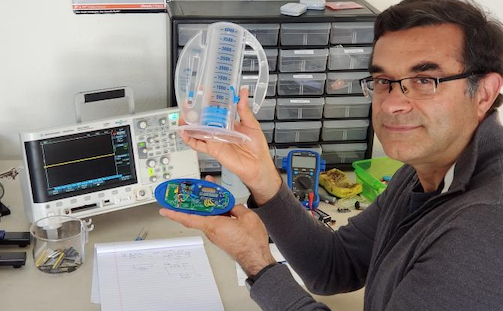In November of 2016, SSU professor Farid Farahmand and a group of engineering students began working on a new invention that assists patients with recovery from respiratory issues. Fast forward nearly four years, that same invention could potentially help patients recovering from COVID-19, as well as other conditions.
InSee, “a patented prototype device that may help to encourage patient compliance of incentive spirometers, including those recovering from severe cases of COVID-19,” according to the Sonoma State news page, is still in development, but Farahmand and his team of Sonoma State engineering students have come a long way.
In an interview from the Sonoma State news page, Farahmand explained that the idea came to him when a friend of his was hospitalized in 2016 and needed to use an incentive spirometer, a device used to measure how deeply one can inhale. When his friend expressed concern about his ability to remember to use the device, Farahmand had an idea to invent something that would both remind the patient to use the spirometer, and track important data related to recovery. After three years of hard work, InSee was born and eventually became patented and trademarked.
The pandemic created a newfound urgency in the medical field for equipment to help treat the violent illness sweeping the United States, and Farahmand’s invention may be just the thing medical professionals are looking for in these desperate times. He acknowledges this in stating, “We hope that the InSee device can assist providers in differentiating patients in terms of their likelihood to develop respiratory complications, thereby allowing them to better allocate vital resources.” This means the device will allow medical professionals to better assess patients’ conditions through the data it will collect, therefore preventing unnecessary use of important equipment. The surge of COVID-19 in the US created a whole new urgency in Farahmand and his students, and they became determined to do their part in combating the illness.
When asked about any new developments on the project, Farahmand stated that “We are currently at the second phase of development and completing the medically compliant prototype of InSee that can be used for clinical trials.” He expects the prototype to be finished in October, and from there, they will begin testing it on a small number of patients suffering from respiratory ailments.
Though his work on this project provided Farahmand and the SSU engineering department with many new opportunities and perks, Farahmand states, “The most rewarding aspect of this project has been the fact that through engaging our students and our collaboration with external partners, we have been able to build a real world device that can help the fight against the COVID-19 pandemic.”
During the process of collaborating and creating with students and local entrepreneurs, Farahmand recalls that each of the hands that helped bring InSee to life were able to contribute something unique, and he couldn’t have worked out all the product requirements without help from the entrepreneurs. He explains that, “This project is yet another testament to the strong talent that exists at Sonoma State University. Our focus on combining fundamentals and hands-on training, as well as developing relevant industry skills, put our…students in a unique position to stand out.”
InSee is still in the early stages of development, but each milestone is another step closer to helping in the fight against COVID-19.





![[Both photos courtesy of sonoma.edu]
Ming-Ting Mike Lee stepped in as the new SSU president following Sakakis resignation in July 2022](https://sonomastatestar.com/wp-content/uploads/2024/04/CC4520AB-22A7-41B2-9F6F-2A2D5F76A28C-1200x1200.jpeg)



























